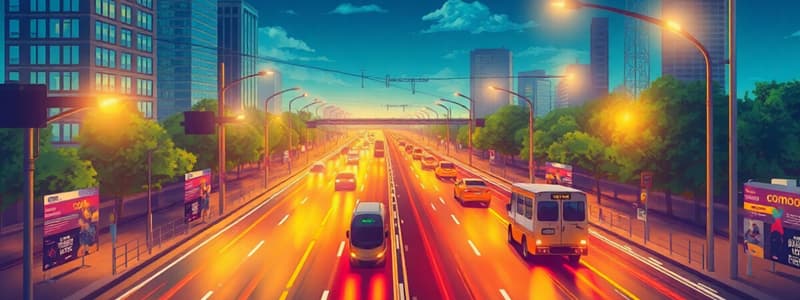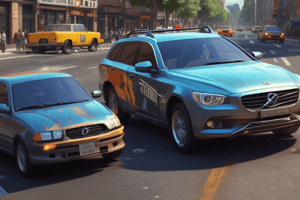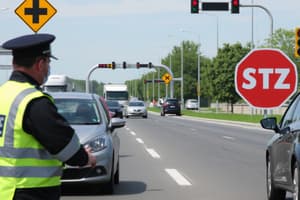Podcast
Questions and Answers
Which of the following scenarios best demonstrates the concept of 'transferability' in movement and transportation?
Which of the following scenarios best demonstrates the concept of 'transferability' in movement and transportation?
- The construction of a new shopping mall attracts more visitors to an area, increasing local business.
- Two competing airlines offer similar routes, but one offers lower prices, attracting more customers.
- A city promotes carpooling to reduce traffic congestion and encourage more efficient use of vehicles.
- A new high-speed train reduces travel time between two cities, making it a more attractive option than driving. (correct)
A city planner is evaluating the potential impact of a new highway on local communities. Which of the following considerations reflects the concept of 'ubiquity' in this context?
A city planner is evaluating the potential impact of a new highway on local communities. Which of the following considerations reflects the concept of 'ubiquity' in this context?
- The environmental impact of the highway on nearby sensitive areas and wildlife habitats.
- The highway's potential to improve connections between residential areas, employment centers, and commercial districts. (correct)
- The cost-effectiveness of the highway construction project compared to other transportation alternatives.
- The highway's capacity to handle the projected volume of traffic during peak hours.
In the context of transportation engineering, which of the following best illustrates the application of 'system analysis'?
In the context of transportation engineering, which of the following best illustrates the application of 'system analysis'?
- Conducting a comprehensive study to evaluate the environmental and social impacts of building a new airport, whilst considering various alternatives and community input. (correct)
- Selecting a bus route based on population density.
- Using a specific type of pavement for a road construction based on material cost.
- Implementing a new traffic signal timing plan to reduce congestion at a particular busy intersection.
When evaluating the 'efficiency' of a transportation system, which of the following factors would be most critical to consider?
When evaluating the 'efficiency' of a transportation system, which of the following factors would be most critical to consider?
A transportation planner is tasked with choosing the most appropriate mode for transporting a large volume of crude oil over a long distance. Considering the characteristics of different transportation modes, which option would be the most suitable?
A transportation planner is tasked with choosing the most appropriate mode for transporting a large volume of crude oil over a long distance. Considering the characteristics of different transportation modes, which option would be the most suitable?
A community is developing a new transportation plan. The aim is to improve the connectivity and accessibility for all residents, especially those in underserved groups. Which initiative would address the issue of 'equality of access'?
A community is developing a new transportation plan. The aim is to improve the connectivity and accessibility for all residents, especially those in underserved groups. Which initiative would address the issue of 'equality of access'?
When designing a transportation facility, which aspect falls under 'geometric design'?
When designing a transportation facility, which aspect falls under 'geometric design'?
In earthwork operations, what is the difference between 'cut' and 'fill'?
In earthwork operations, what is the difference between 'cut' and 'fill'?
What is the primary purpose of superelevation on a curved section of a highway?
What is the primary purpose of superelevation on a curved section of a highway?
A transportation engineer is tasked with mitigating the negative impacts of a new highway construction project on nearby residential areas. Which strategy is best suited to address the potential issue of 'noise pollution'?
A transportation engineer is tasked with mitigating the negative impacts of a new highway construction project on nearby residential areas. Which strategy is best suited to address the potential issue of 'noise pollution'?
Flashcards
Transportation Engineering
Transportation Engineering
Planning, design, operation, and management of transport systems.
Traffic Engineering
Traffic Engineering
Focuses on road planning, geometric design, construction, and traffic operations.
Highway Engineering
Highway Engineering
Subset of Transportation Engineering dealing with planning, design, construction, etc. of roads, bridges, and tunnels.
Physical Facilities
Physical Facilities
Signup and view all the flashcards
Physical Civil Engineering
Physical Civil Engineering
Signup and view all the flashcards
System Engineering
System Engineering
Signup and view all the flashcards
Links
Links
Signup and view all the flashcards
Traffic Congestion
Traffic Congestion
Signup and view all the flashcards
Two-Lane Highway
Two-Lane Highway
Signup and view all the flashcards
Runway
Runway
Signup and view all the flashcards
Study Notes
- The importance of transportation in world development is multidimensional.
- Transportation's basic function is to link residences with employment and producers to the users of goods.
- Early transportation involved humans using vehicles since they learned to walk.
- Horse-drawn carriages moved at approximately 4MPH in the late 1800s.
- Electrically propelled transportation was introduced in the 1880s.
- Daimler and Benz developed gasoline-powered internal combustion engines in 1885.
- Motor vehicles have revolutionized private transportation around the world over the past 100 years.
Field of Transportation Engineering
- Transportation engineering involves the planning, design, operation, and management of transport systems for safe, fast, comfortable, economical, and eco-friendly movement of people and goods.
- Traffic engineering focuses on road planning, geometric design, construction, and traffic operations like streets, highways, networks, terminals, and urban links.
- Highway engineering is a subset of transportation engineering under Civil Engineering, dealing with the planning, design, construction, operation, and maintenance of roads, bridges, and tunnels for safe transportation.
Transportation System Components
- Transportation system includes physical facilities, fleets, operating bases, and facilities including vehicle maintenance facilities and office space, and organizations.
- Physical facilities for the transportation systems includes roads, streets, highways, railroads, airports, sea and river ports, pipelines, and canals.
- Fleets comprise vehicles, vessels, and aircraft.
- Facility-oriented organizations are mainly involved in planning, designing, constructing, maintaining, and operating fixed facilities
- Department of Transportation, Department of Public Works and Highways and Metro Manila Development Authority, are examples of transportation organizations.
- Operating organizations, also known as carriers, are mainly concerned with operating fleets to provide transportation services.
- Railroads, airlines, ship/barge lines, truck lines, transit operators, and private individuals who operate automobiles, motorcycles, and bicycles, are examples of operating organizations.
- Operating strategies encompasses vehicle routing, scheduling, and traffic control.
- Physical civil engineering is a civil engineering activity related to providing physical facilities and their design, construction, and maintenance.
- Systems engineering is a civil engineering activity related to planning and operating transportation systems, accounting for transportation demand, system capacity, traffic control, and operating strategies.
Transportation System Objectives and Constraints
- The objective of transportation is to knit together inhabitants, providing mutual access and communication in a territory.
- Human impact is one constraint on transportation.
Nature of Transportation Engineering
- The nature of transportation engineering has an interdisciplinary breadth including many topics.
- Social sciences, planning and architecture, mathematics, physical sciences, geometric design, economics, system engineering, statistics, soil mechanics and traffic engineering are all encompassed by the nature of transit engineering.
Transportation as a System
- Airways, conveyors, highways, pipelines, railways, and waterways, are types of transportation.
- Multi-modal describes when two or more modes are paired to supply utilities and services to the public.
- Exotic modes are areas that are not yet being used commercially but are being tested in a pilot project.
- Quasi-transport includes communication methods like telephones, facsimile, Waze, the internet, Facebook Messenger, and Skype.
Modes of Transportation include
- Highways, the dominant transportation mode used by private vehicles, truck lines, and bus lines.
- Urban transit, including buses, streetcars, mass transit, light rail, and rapid rail transit.
- Air including commercial airlines, airfreight carriers, and general aviation.
- Rail that covers public and private railroads.
- Water which includes coastwise ocean shipping and barge lines.
- Pipelines for very low-speed and high-capacity continuous flow transportation, which require a large amount of working storage such as crude oil, petroleum products, and natural gas.
- Other modes includes cable and belt systems, ski lifts, and moving belts in airports.
System Analysis
- A system is defined as a set of interrelated parts called components that perform functions to achieve common goals.
- System analysis encompasses the application of the scientific method to solve complex problems.
- Goals are the desired end state.
- Objectives are operational statements of goals that have been made measurable and are attainable, therefore they will suggest measures of effectiveness.
- Measures of Effectiveness (MOE) measure the degree to which each action/alternative satisfies the objective.
- Measures of Costs (MOC) measures programs' benefits or the opportunities lost because of that action.
- A standard establishes a fixed objective (the lowest or highest level of performance accepted).
- A policy is a guiding principle/course of action that forwards progress toward an objective.
Steps in System Analysis
- Recognize community problems and values
- Establish goals
- Define objectives
- Establish criteria
- Explore alternative actions
- Evaluate alternatives (effectiveness & costs)
- Question objectives & assumptions
- Examine/modify alternatives
- Establish new objectives (if needed)
- Repeat cycle until a satisfactory solution is reached
Movement and Transportation
- Three conditions explain why people & goods move, these include:
- Complementarity, attraction between two places
- Transferability, overcoming distance (time, cost, technology)
- Competition, competing opportunities between locations.
Transportation Policy Making
- Transportation planners and engineers recognize that the transportation system is a potent force in shaping regional and urban development.
- Transportation accommodates social interactions, plus, the planning and development of transportation facilities efficiently raises living standards and enhances the aggregate of community values.
- Geographers describe trips as an event and travel as a process.
- Land use is one of the primary determinants of movement and activity.
- Trip generation dictates the transportation facilities needed, such as streets and bus systems.
Overview of Transportation System Characteristics
- Links, roadways pathways and railways
- Vehicles, cars, buses, ships, planes and bikes
- Terminals, parking areas, bus stops and train stations.
- Management and labor includes operators, planners, and maintenance teams.
Researchers Identified Nine Categories Of Human Behavior Affected By Transportation.
- Locomotion (passenger, pedestrian)
- Activities (vehicle control, maintenance, & community life)
- Feelings (comfort, convenience, enjoyment, stress, likes, dislikes)
- Manipulation (modal choice, route selection, & vehicle purchase)
- Health and safety (accidents, disabilities, & fatigue)
- Social interaction (privacy, territoriality, conflict, & imitation)
- Motivation (positive or adverse consequences, & potentiation)
- Learning (operator training, driver education, & merchandising)
- Perception (images, mapping, sensory thresholds)
Eleven Properties of the Physical Environment That Have Direct Impact On Human Behavior:
- Spatial organization encompasses the shape, scale, definition, bounding surfaces, internal organization of objects/society, and their connections to different spaces/settings.
- Circulation and movement includes people, goods, and objects used for movement like cars, trains, highways, and rails.
- Communication includes both explicit and implicit signals like, signs and symbols.
- Ambience includes microclimate, light, sound, and odor.
- Visual properties includes color, shape and other modalities.
- Resources consist of physical components and aspects like paths, terminals, and usage.
- Symbolic properties consist of social values, attitudes, and cultural norms.
- Aesthetic properties refers to the sensory and aesthetic properties of the environment
- Consequential is the characteristic of the environment that strengthens or weakens behavior.
- Protection includes safety factors
- Timing includes scheduling in time with cyclical rhythms.
- Ubiquity is the amount of accessibility to the system. +Mobility is the quantity of traffic that is handled. This encompasses traffic and speed
- Efficiency: Encompasses the relationship between the cost of transportation and system productivity, including capital, operating costs, adverse impacts, and safety.
Chapter 2 - Transportation System Issues and Challenges:
- Traffic congestion happens when demand exceeds the capacity of the transportation system that the urban highway encounters.
- Accident rates are a trend affected by organizational agencies involved in transportation safety.
- Responsibilities and legal concerns include tort liability (liability for damages in cases where unsafe conditions lead to personal injury or property damage).
- Meeting increasing public expectations for improved safety is face with public impatience.
- Providing access to transportation systems includes accommodating people who are poor, elderly, and/or physically handicapped.
- Environmental protection considerations must be addressed, including:
- Displacement of residents and businesses
- Noise pollution from construction and operation
- Wildlife impact disrupting natural habitats
- Water quality declines due to construction
- Visual impacts changing the landscapes
- Temporary construction impacts including noise, dust, and water erosion
- Sensitive areas at risk such as wetlands and coastal zones
- Using new technology like GPS, Waze, and Google Maps.
Chapter 3: Introduction to Physical Design of Transportation Facilities:
- ASTM, AASHTO, and the Civil Aviation Board provide design standards.
- ASTM provides standards for materials and construction of transportation infrastructure to ensure quality.
- AASHTO sets guidelines for the design, construction, and maintenance of highways and transportation systems
- Civil Aviation Board: Regulates aviation policies, safety and infrastructure for air transportation.
Design Documents
- The design documents includes bid documents with plans, specifications, and estimates (for cost).
Chapter 4: Geometric Design:
- Designing features like geometric cross sections, horizontal alignment, vertical alignment, intersections, and various design details, are elements of geometric design for transportation facilities.
- The goal of geometric design is to maximize comfort, safety, and economy while minimizing environmental impact.
- Important notes include:
- Hangers for parking
- Taxiways for loading and unloading
- Runways strips of land for aircraft take off.
- A two-lane highway for cross section is a road with one lane for traffic going in each direction, usually separated by a center line.
- A divided highway with a depressed median and ditches is a road with two separate lanes of traffic, with a lowered middle section and ditches to help with drainage and prevent accidents.
- A railroad geometric cross-section shows the structure of railway tracks.
Vertical Alignment
- Documented by a profile which is a graph containing elevation, measured stations and distance along the centerline referenced line of the facility
- Horizontal alignment consists of tangents, circular cues, and possible transitional cues.
- Curves’ super-elevation helps counteract centripetal acceleration."
- Transportation facilities must provide resolution of traffic conflicts for intersections and interchanges.
- A intersection is where two+ roads cross at equal level- traffic control is required.
- A interchange uses ramps and bridges to allow continuous flow of traffic.
Chapter 5: Earthwork for Transportation Construction
- Transportation projects involve amounts of earthwork to minimize that expense
- Earthwork quantities are in metric units volumes for highway and railways volumes, estimated on cross sections areas by distance
- Vertical distances measured grade elevations and horizontal are measured along the profile from centerline
- Cutting (excavation) removes high soil & filling (embankment) adds soil in lower ground
- Diagrams includes; calculation of optimum strafes and earth costs from the diagram
- Mass Diagram is a graph of cumulative volume of earthwork that CUT is positive and FILL is negative
Studying That Suits You
Use AI to generate personalized quizzes and flashcards to suit your learning preferences.




